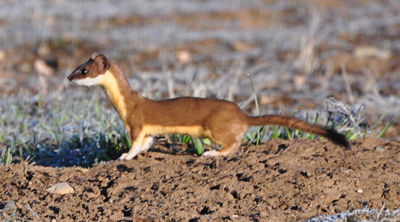Dr. Ray L. Winstead
Professor of Biology (retired), Indiana University of
Pennsylvania
Blue Spruce Park
April 10, 2018
![]()
![]()

Public Domain photo from Wikimedia
Dr. Ray L. Winstead |
|
A sudden commotion of running and yelling immediately captured my attention earlier this afternoon (April 10, 2018) out at Blue Spruce Park. While feeding the chickadees out of my hand for an hour at my usual spot (near the chickadee sign on Getty Run Trail) I heard this ruckus down the trail a short distance to my right away from the playground. Two Long-tailed Weasels (!) were racing up a large tree trunk, one appearing to be chasing and one appearing trying to escape! I heard scampering feet moving fast over the bark, and at least one of them was “yelling.” Having seen a Short-tailed Weasel out at Blue Spruce a number of years ago I immediately keyed in on the tails. (Both Long-tailed Weasels and Short-tailed Weasels are found in western Pennsylvania.) The bodies of both brown individuals were long and skinny, and their tails were also narrow and almost as long as the rest of their bodies, very different than a Short-tailed Weasel. They were about 17 inches long, including their long tails.
(Grey Squirrels, Red Squirrels, and Chipmunks are often seen in the same area, and these two individuals were noticeably different. More recently I have had a Red Squirrel coming up close to me both on the ground and on the branches right in front of me a number of times as I feed the chickadees. I figure this is too close for my own safety, since he easily could make a short jump onto me to get to the seeds, so I have been discouraging that by making sudden movements. Today a chipmunk, as often is the case, was also coming close to me.)
The two weasels ran up the tree trunk at least 50 feet. The lead weasel ran out to the end of a high branch with the chaser close behind. The leader hesitated only briefly and then launched himself/herself into the air! He was really up there high, as I said, at least 50 feet up, jumped, opened up, and “sort-of glided,” or tried to glide like a flying squirrel. He jumped toward my general direction, spreading out his short legs, but did not demonstrate any wide gliding surface as you would see on a flying squirrel. With his long tail streaming behind I guess his stance did slow him down some, and his jump (and gliding) propelled him quite a ways horizontally away from the tree. He landed nearby but out of my direct sight over the edge of a little embankment in the little stream area. Besides the little stream in that area there was also a “sandbar” nearby on the other side of the stream where the jumper could have landed. Although I was probably close enough, I did not hear a splash or landing, so he probably landed on soft ground, such as the sandbar. The chaser rapidly ran down the tree trunk and over to the area where the jumper had landed, but he then kept going in the direction of the lake. A little later I walked over to the landing area, but I saw no evidence of the jumper/leader. (The next day I examined the other side of the stream more carefully, and I DID find more than 20 fresh-looking footprints of the right size in the mud on the sandbar. The footprints could have been from the jumper, the chaser, or both of them. A triangular measurement of the height of the branch above the base of the tree was exactly 53 feet, and the streambed sandbar was another two feet down, so the height from the branch to the sandbar was 55 feet.*)
Long-tailed Weasels are usually solitary, secretive, and most of the time nocturnal. Both males and females usually defend their own, individual territories. (However, maybe the ones I saw were just playing!) They are efficient predators, usually eating a variety of small mammals, some larger than themselves. According to the Pennsylvania Game Commission, the breeding season is usually in July and August with the young being born the following April or May. (Embryos develop a little initially, then lie dormant over the winter until development begins again about a month before birth.) The male may take food to the mother and young.
When you are out at Blue Spruce Park expect the unexpected! You are also encouraged to spend some time looking for something neat whenever and wherever you are in the park, since it is probably right there in front of you, if you look for it. Be Aware of your environment! (To learn more about feeding the chickadees at Blue Spruce Park see HERE.)
* The method used to estimate the height of the branch was the first method described at https://www.wikihow.com/Measure-the-Height-of-a-Tree. A second observer verified the horizontal orientation of the cardstock isosceles right triangle used. Another method "recommended" but not used was: "Climb to top of tree with stop watch. Begin timing your descent as you allow yourself to freely fall from tree, taking care not to hit any branches. Just as you land, stop timing yourself. Locate a stick about the size of a pencil. Using your blood as ink and a leaf as paper, solve the equation d = 4.9*t^2 where t is the time recorded by your stop watch and d is the distance you fell, equal to the height of the tree. If you hit any branches, try again." (RLW note: further investigation shows that this equation gives the calculated distance in meters, when t is given in seconds.)
Back to Blue Spruce Chickadees
| Current Percentage Metric Time is |
|
O'Clock |